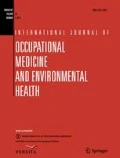Abstract
Objectives
The study presents data concerning occupational exposures among the staff of 5 hospitals in the Małopolska province in 2008–2012, taking into account the frequency and circumstances of exposure formation, occupational groups of hospital workers, as well as diversification of the reported rates in subsequent years between the hospitals and in each of them. An additional objective of the analysis was to assess the practical usefulness of the reported data for planning and evaluation of the effectiveness of procedures serving to minimize the risk of healthcare workers’ exposure to pathogens transmitted through blood.
Material and Methods
Data were derived from occupational exposure registries kept by 5 hospitals of varying sizes and operational profiles from the Małopolska province from the years 2008–2012.
Results
Seven hundred and seventy-five cases of exposure were found in a group of 3165 potentially exposed workers in the analyzed period. Most cases were observed in nurses (68%) and these were mainly various types of needlestick injuries (78%). Exposure rates with respect to all workers ranged from 2.6% to 8.3% in individual hospitals, but the differences in their values registered in the hospitals in subsequent years did not bear any statistical significance, in a way similar to the rates calculated separately for each occupational group.
Conclusions
There was no upward or downward trend in the number of reported cases of exposure to bloodborne pathogens in the studied period in any of the hospitals. Statistically significant differences in the percentages of exposures were reported between individual hospitals in some years of the analyzed period, which confirms the need for registries in individual units in order to plan and evaluate the effectiveness of preventative measures.
Similar content being viewed by others
References
Deuffic-Burban S, Delarocque-Astagneau E, Abiteboul D, Bouvet E, Yazdanpanah Y. Blood-borne viruses in health care workers: Prevention and management. J Clin Virol. 2011;52:4–10, http://dx.doi.org/10.1016/j.jcv.2011.05.016.
Tarantola A, Abiteboul D, Rachline A. Infection risks following accidental exposure to blood or body fluids in health care workers: A review of pathogens transmitted in published cases. Am J Infect Control. 2006;34:367–375, http://dx.doi.org/10.1016/j.ajic.2004.11.011.
Pruss-Ustun A, Rapiti E, Hutin Y. Estimation of the global burden of disease attributable to contaminated sharps injuries among health-care workers. Am J Ind Med. 2005;48: 482–490, http://dx.doi.org/10.1002/ajim.20230.
Wilczyńska U, Sobala W, Szeszenia-Dąbrowska N. [Occupational diseases in Poland, 2012]. Med Pr. 2013;64(3):317–326, http://dx.doi.org/10.13075/mp.5893.2013.0027. Polish.
Szczeniowski A, Gańczak M. [The implementation of legislation acts regarding prevention of occupational exposure to bloodborne pathogens from perspective of Poland as the UE country]. Med Pr. 2011;62(1):57–66. Polish.
[Regulation of the Minister of Health of 6 June 2013 on occupational health and safety when performing work involving exposure to injury from sharp instruments used in providing health services. J Laws 2013, No. 696 (June 6, 2013)]. Polish.
Szczypta A, Wójkowska-Mach J, Kulikowski J, Bulanda M, Heczko PB. [Surveillance of bloodborne infections]. Zakazenia. 2004;6:76–81. Polish.
Baran M, Wójkowska-Mach J. [Occupational exposure of potentially infectious material in John Paul II hospital in Krakow]. Zakazenia. 2008;5:98–101. Polish.
Nienhaus A, Kesavachandran C, Wendeler D, Haamann F, Dulon M. Infectious diseases in healthcare workers — An analysis of the standardised data set of a German compensation board. J Occup Med Toxicol. 2012;7:8, http://dx.doi.org/10.1186/1745-6673-7-8.
Hoffmann C, Buchholz L, Schnitzier P. Reduction of needlestick injuries in healthcare personnel at a university hospital using safety devices. J Occup Med Toxicol. 2013;8: 20, http://dx.doi.org/10.1186/1745-6673-8-20.
Gańczak M, Szych Z, Karakiewicz B. [Assessment of occupational exposure to HBV, HCV and HIV in gynecologic and obstetric staff]. Med Pr. 2012;63(1):11–17. Polish.
Rybacki M, Piekarska A, Wiszniewska M, Walusiak-Skorupa J. Work safety among Polish health care workers in respect of exposure to bloodborne pathogens. Med Pr. 2013; 64(1):1–10, http://dx.doi.org/10.13075/mp.5893/2013/0001.
Wicker S, Jung J, Allwinn R, Gottschalk R, Rabenau HF. Prevalence and prevention of needlestick injuries among health care workers in a German university hospital. Int Arch Occup Environ Health. 2008;81:347–354, http://dx.doi.org/10.1007/s00420-007-0219-7.
Winchester SA, Tomkins A, Cliffe S, Batty L, Ncube F, Zuckerman M. Healthcare workersł perceptions of occupational exposure to blood-borne viruses and reporting barriers: A questionnaire-based study. J Hosp Infect. 2012; 82:36–39, http://dx.doi.org/10.1016/j.jhin.2012.05.013.
Gańczak M, Bohatyrewicz A, Korzeń M, Karakiewicz B. The comparison of sharps injuries reported by doctors versus nurses from surgical wards in the context of the prevalence of HBV, HCV and HIV infections. Pol J Surg. 2012; 84(4):190–195, http://dx.doi.org/10.2478/v10035-012-0031-2.
Garus-Pakowska A, Szatko F. [Percutaneous exposures in medical personnel]. Med Pr. 2011;62(5):473–480. Polish.
Parszuto J, Jaremin B, Bardoń A, Obuchowska A. [Occupational HBV and HCV infections among health care workers]. Med Pr. 2012;63(4):441–452. Polish.
Gańczak M, Milona M, Szych Z. Nurses and occupational exposures to bloodborne viruses in Poland. Infect Control Hosp Epidemiol. 2006;27:175–180.
Author information
Authors and Affiliations
Corresponding author
About this article
Cite this article
Różańska, A., Szczypta, A., Baran, M. et al. Healthcare workers’ occupational exposure to bloodborne pathogens: A 5-year observation in selected hospitals of the Małopolska province. IJOMEH 27, 747–756 (2014). https://doi.org/10.2478/s13382-014-0307-3
Received:
Accepted:
Published:
Issue Date:
DOI: https://doi.org/10.2478/s13382-014-0307-3



